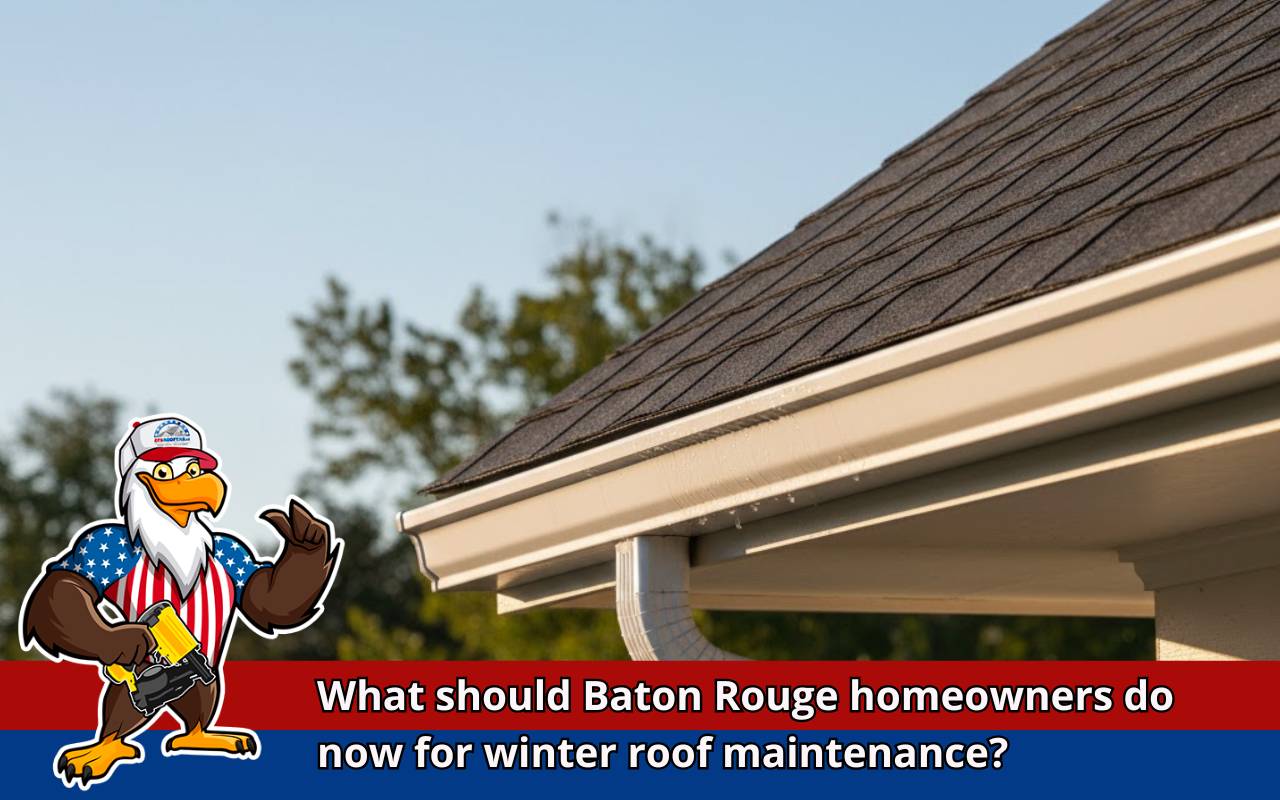
Winter Roof Maintenance Baton Rouge matters long before a cold front arrives. In our humid, storm-prone climate, small issues can quickly escalate into leaks, energy loss, and emergency repairs. This guide explains what to inspect, clean, and fix so you’re storm-ready. You’ll learn about clogged gutters, flashing inspection, and attic ventilation in winter—and when to call pros—to protect comfort, safety, and your investment.
What should Baton Rouge homeowners do now for winter roof maintenance?
Prioritize Winter Roof Maintenance Baton Rouge by clearing clogged gutters, scheduling a flashing inspection, confirming attic ventilation in winter, and documenting storm readiness with photos and receipts. Tackle quick fixes now—sealants, loose shingles, and tree limbs—then book a pro inspection if anything looks questionable. This mix of DIY and expert care minimizes leaks, preserves energy efficiency, and keeps your home resilient through winter storms.
Importance of Winter Roof Maintenance in Baton Rouge
Winter Roof Maintenance Baton Rouge is about prevention. Heavy rains, sudden temperature swings, and gusty winds can loosen shingles, open seams, and overwhelm drainage. Proactive upkeep reduces leaks, mold, and mid-season repair costs—especially when contractors are busiest. Improve efficiency by stopping drafts, keeping insulation dry, and ensuring smooth airflow. Use our roof maintenance tips to build a plan that fits your home and budget.
Common Winter Roof Issues to Watch Out For
- Clogged gutters and downspouts causing overflow near eaves and foundations.
- Damaged or missing shingles exposing underlayment to wind-driven rain.
- Failed sealant at penetrations after a neglected flashing inspection.
- Condensation from poor attic ventilation in winter leading to mold.
- Debris piles in valleys that trap moisture and accelerate wear.
Inspecting and Cleaning Gutters
Clogged gutters are a top culprit in Baton Rouge. Clean them in late fall and again before major rain. Wear gloves, use a ladder stabilizer, scoop debris, flush with a hose, and check hangers and seams. For a seasonal plan, see our seasonal roofing checklist.
- Remove leaves, pine needles, and roof grit.
- Flush leaders and confirm downspout extenders.
- Inspect for sagging, leaks, or loose fasteners.
Checking for Leaks and Damaged Shingles
Scan from the ground with binoculars or walk the roof only with proper safety gear. Look for curling, cracked, or missing shingles. Inside, use a flashlight to find dark stains, damp insulation, or musty odors. Early action protects sheathing and drywall; use our roof inspection guide to document findings before calling a pro.
Ensuring Proper Attic Ventilation
A balanced system keeps your roof deck dry and efficient. Clear soffit intakes, verify ridge or gable exhaust, and add baffles to maintain airflow paths. Correct attic ventilation in winter reduces condensation, mold risk, and heat loss while stabilizing indoor comfort.
- Confirm unobstructed soffit vents along eaves.
- Check ridge vents for cracks, nests, or blockages.
- Install baffles to prevent insulation from blocking airflow.
Assessing Flashing and Seals
Flashing inspection is vital for storm readiness. Examine metal at chimneys, skylights, and vents; reseal any gaps or rusted sections. Replace brittle caulk and secure loose counter-flashing. Even tiny voids can become costly leaks when winter storms roll through.
Trim Tree Branches and Overhanging Limbs
Cut back limbs brushing shingles or hovering over the roof. Remove dead or weakened branches within a safe radius to reduce puncture and impact risks during wind events. Pruning also improves airflow and helps the roof dry faster after rain.
Professional Roof Inspection and Maintenance Services
Pros spot subtle issues—underlayment damage, hidden leaks, and ventilation imbalances—you might miss. Ask for a written report with photos and prioritized repairs to strengthen storm readiness. If you see warning signs, contact 225 Roofers for a timely assessment and targeted fixes.
DIY vs. Professional Roof Maintenance: Which is Better?
DIY covers simple cleaning and visual checks; professionals handle complex sealing, flashing, and steep or high roofs. A hybrid approach saves money without sacrificing safety: you handle routine upkeep while licensed roofers complete detailed repairs and confirm code-compliant performance.
Frequently Asked Questions
How often should I clean gutters in Baton Rouge winters?
At least twice: once in late fall and once before forecasted heavy rain, plus after major wind events.
Do I need special ventilation if we rarely freeze?
Yes. Consistent airflow prevents condensation, mold, and energy loss regardless of freezing frequency.
What’s the fastest way to spot early leaks?
Check the attic after rain with a flashlight—look for dark stains, damp insulation, or musty odors.
Is DIY flashing repair safe for beginners?
Minor resealing is possible, but extensive flashing work is best handled by licensed professionals.
When should I call a roofer?
Call if you notice recurring stains, widespread shingle wear, soft decking, or uncertain ventilation paths.
Taking Steps Now for a Secure Winter Roof
By acting early on Winter Roof Maintenance Baton Rouge—clearing drains, confirming airflow, and tackling a thorough flashing inspection—you’ll reduce risk and improve comfort. For a tailored plan and verified storm readiness, book a professional evaluation and keep documentation current to support warranties and insurance claims.
How to Winterize Your Baton Rouge Roof
- Photograph the roof, gutters, and penetrations to create a baseline.
- Clear clogged gutters and flush downspouts; install extenders if needed.
- Perform a flashing inspection at chimneys, skylights, and vents; reseal gaps.
- Check attic ventilation in winter: clear soffits, verify ridge exhaust, add baffles.
- Replace damaged shingles and secure loose fasteners.
- Trim overhanging limbs and remove roof/deck debris.
- Document work and schedule a professional inspection for storm readiness.
References
Popular Mechanics — How to Inspect Your Roof
